Rewritten in 2023 with better examples and current info.
What is the diameter, hole size, and thickness of 45lb plates, and what are the reasons for it?
Table of Contents
45lb Olympic Plate Diameter
A 45 lb plate diameter measurement is supposed to be 450mm (17.72″). This is the IPF (International Powerlifting Federation) and IWF (International Weightlifting Federation) regulation size.
This goes for most models of olympic plates, including:
- Bumper Plates – Solid rubber plates used for the clean-and-jerk and the snatch in Crossfit and olympic weightlifting. See below for more on this.
- Powerlifting Discs – Solid steel calibrated plates used in powerlifting competitions. Expensive!
- 45lb Cast Iron Plates – Some 45lb (and 100lb, less common) cast iron plates are made to the 450mm spec, for models that undergo the extra expense of machining to exact dimensions and weight. Other models can vary from 430mm to 470mm.
Bumper Plates Diameter
Bumper plates are a particular type of olympic sized plate, made with solid rubber.
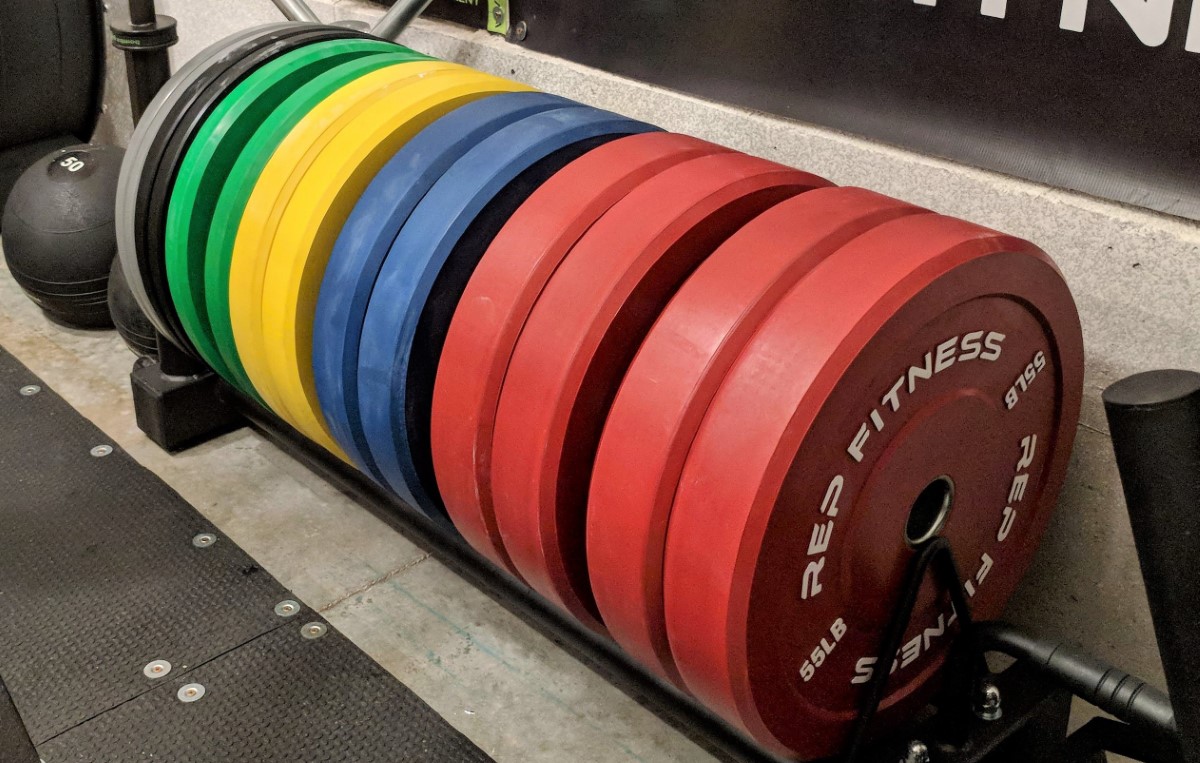
As with iron 45lb olympic plates, bumper plates are 450mm / 17.72″ diameter. This includes the 10lb all the way up to 45lb, or if in kilograms, the 5kg all the way to 25kg. Bumper plates only vary in thickness. This is so all of the bumper plates contact the ground together when the barbell is dropped.
They are more targeted towards the olympic lifting market, so the IWF specification is taken more seriously and they tend to meet the 450mm spec. Even so, Hi-Temp bumpers are more like 17.5″ or 440mm.
Are They Always 450mm?
Unfortunately not. I’ll explain.
There are a few reasons for the 450mm specification:
- The bar shaft is sitting at an exact height of 211mm (assuming a 28mm diameter shaft) from the floor when the lifter begins a lift such as a deadlift or clean. This is important for competition consistency. If you’re not competing, this doesn’t necessarily matter a whole lot. It also makes no difference for racked exercises like the bench press.
- Dropping the barbell is rough on plates, and if all the plates don’t reach the floor, the ones taking the shock load might not be able to handle it and can break. Even bumper plates are only engineered to take a little more than their own weight when dropped.
- If only some plates are touching the floor and there’s any slack in the hole sizing on them, you’ll end up with a bad pull as you’re lifting some weight while still pulling slack out of the rest of the weights.
- Cody in the comments below suggests the plate size is engineered big enough so that most humans skulls don’t get crushed by the bar if you drop it on yourself on the floor.
Some people gather plates over the years for their gyms and aren’t always able to get the same brand and model of plates each time. The odds of getting two brands of plates of a non-standard diameter to match up are pretty hopeless. However, if it’s 450mm diameter, your odds of getting some functionally matching plates drastically improve.
For example, the Troy model ‘PO’ plates are the same 450mm diameter as others and work good with anything made to this spec. They are the old-fashioned design of wide-flange / deep dish plates.
On the other hand, these 45 lb economy plates are measured at 451mm. These are what are included in low priced 300 lb olympic weight sets.
Any cast iron plate 35lb or lighter will be smaller. The diameters are only the same for 45lb and 100lb (when the particular model is even made in a 100lb size) plates.
Center Hole Diameter
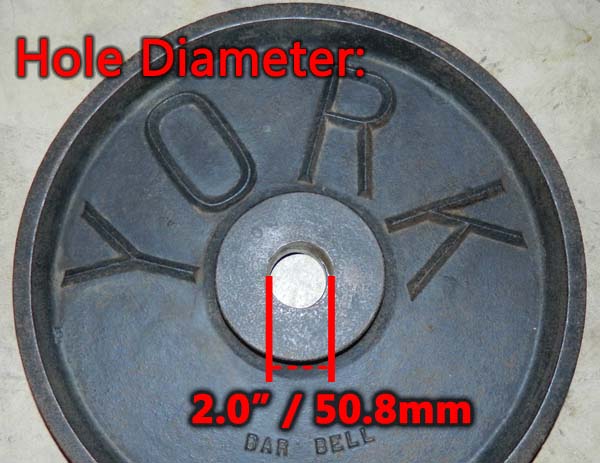
In a perfect world, all olympic plates would at least have the same sized holes and all olympic bars would have the same sized sleeves. That isn’t always the case.
You can’t fit a 2″ rod into a 2″ hole (without lots of pounding), so good Olympic bars have sleeves in the range of 49.8mm-50.0mm (1 31/32″), and good Olympic plates have holes just slightly larger than 50mm, such as 50.4mm or 50.8mm (exactly 2.0″).
What happened at some point was manufacturers started making cheaper olympic plates with holes a little larger than 2″. That way plates with casting defects in the holes would still fit the bars. So they have a very sloppy fit, which is annoying for any type of lift you do off the floor, such as deadlifts, cleans or snatches, because you have to pull the slack out.
Because their plates were so loose, the manufacturers making these cheap plates didn’t care about the bar sleeves being exactly 50mm, so they made the bar sleeves about 2″ (50.8mm) and sold them with their plates in weight sets. That worked out well enough, because those weight sets were marketed towards people who didn’t know anything about weights anyway and the sloppy fit wouldn’t bother them. Today, even casual lifters more and more are conscious of quality and have access to better equipment instead of relying solely on their local chain sporting goods store. They tried to fit high-quality plates on a cheap bar and the plates got stuck.
Good machined plates are made for a snug fit. No-name, “Standard”, or “Economy” plates, and all current York plates have a sloppy fit. Sometime in the early 2000s, York made the decision to make their holes a little larger, and they stuck with that decision to the dismay of long-time York fans.
Nowadays most manufacturers make their bar sleeves right around 49.8mm-50.0mm diameter. Even the bars under $200 have this measurement right.
One exception would be a “fat” bar made entirely with 2″ (50.8mm) pipe down the shaft and ends. They usually come with special collars made to a fit over a 2″ end.
Some non-specialized sporting goods equipment retailers who sell fitness equipment are ignorant of the whole issue on sizing and just assume all olympic stuff will always fit each other. This is why it’s important to do your shopping with a company that understands what they sell.
Standard Weight Plates Diameter
As far as “standard” plates, it depends on what you mean by standard.
For example, here’s what many people call a standard plate:
Frequently the run-of-the-mill Chinese-made olympic plates will have raised lettering that says “STANDARD” as above. This is just to confuse you. They started doing this many years ago.
So for the above, see the notes above for olympic plates, because that’s what it is.
Normally what we call standard plates are the type with 1″ holes. The above has 2″ holes like other olympic plates and therefore should not be called a standard plate. For clarity we might call it a “standard olympic plate” or “olympic standard plate” to be clear that it’s olympic with the STANDARD lettering on it.
Here is a standard plate:
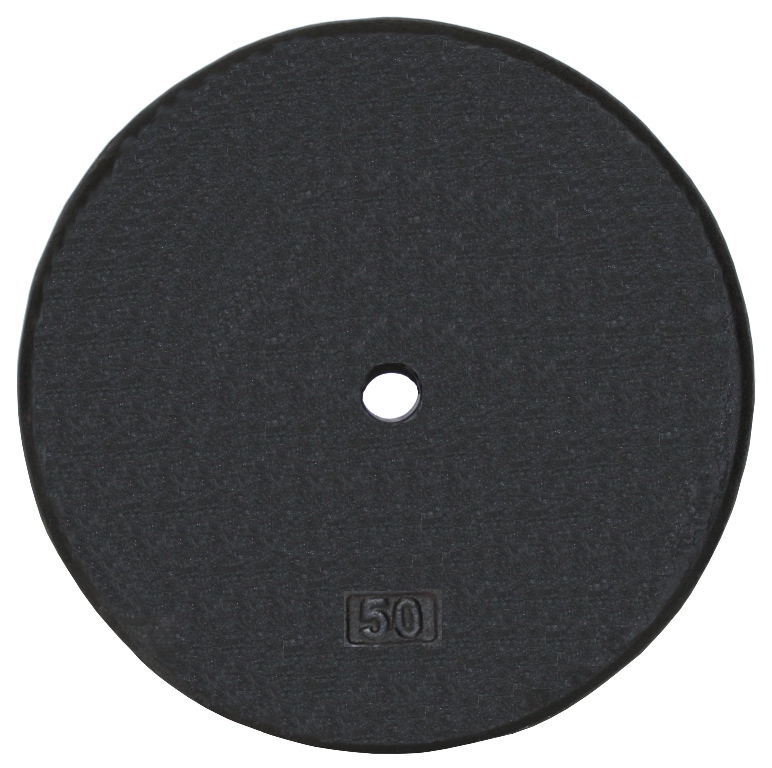
Standard plates with 1″ holes like this don’t typically even come in a 45lb size. The above is a 50lb. They’re denominated in round numbers of pounds like that instead of converted from an approximate kg size such as how 20kg = 44lb.
A standard plate diameter could vary a lot. Some may be 14.5″ for the 50lb size, and 11.38″ for the 25lb size.
The hole diameter is a little over 1″, possibly 1 1/16″ or 1 1/8″.
Standard plates are used far less frequently in commercial environments and even less frequently today in personal home gyms. They are also called pancake plates, or exercise plates. They are mainly used now in certain lightweight barbell training classes, using a hollow bar that weighs only 5 lbs, and the smaller sizes (10lb and smaller) are used to construct pro-style dumbbells.

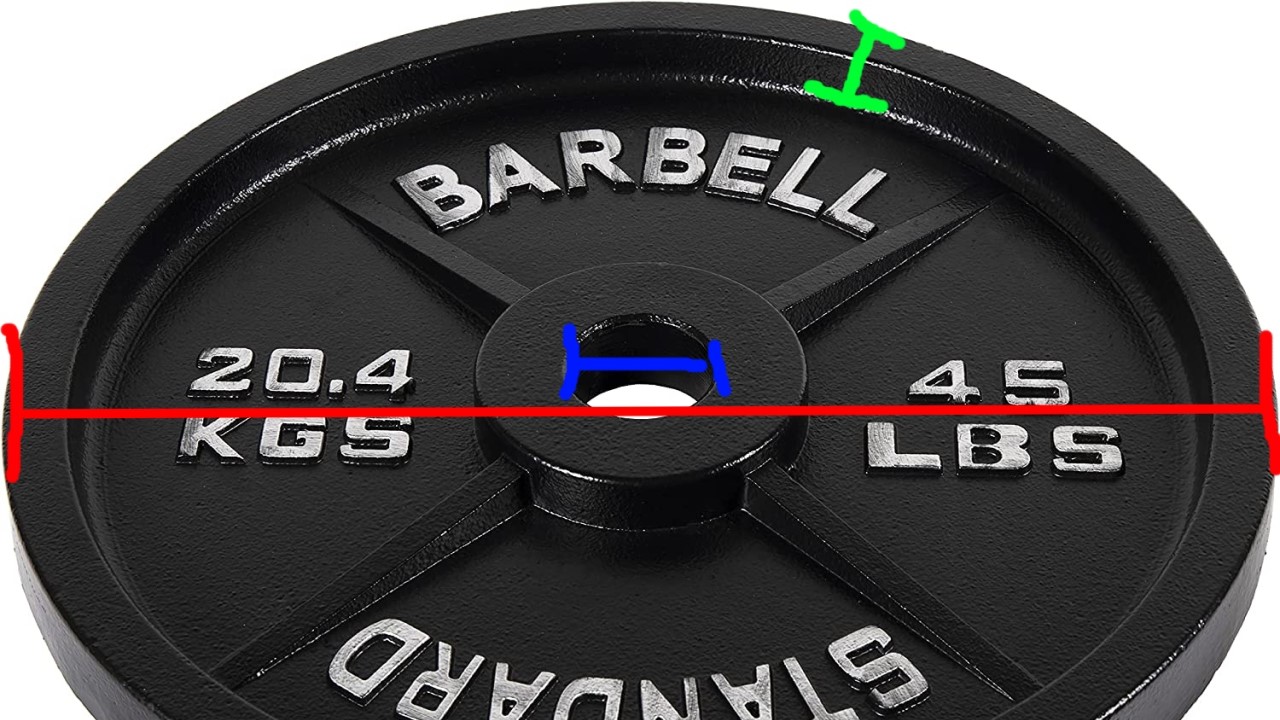
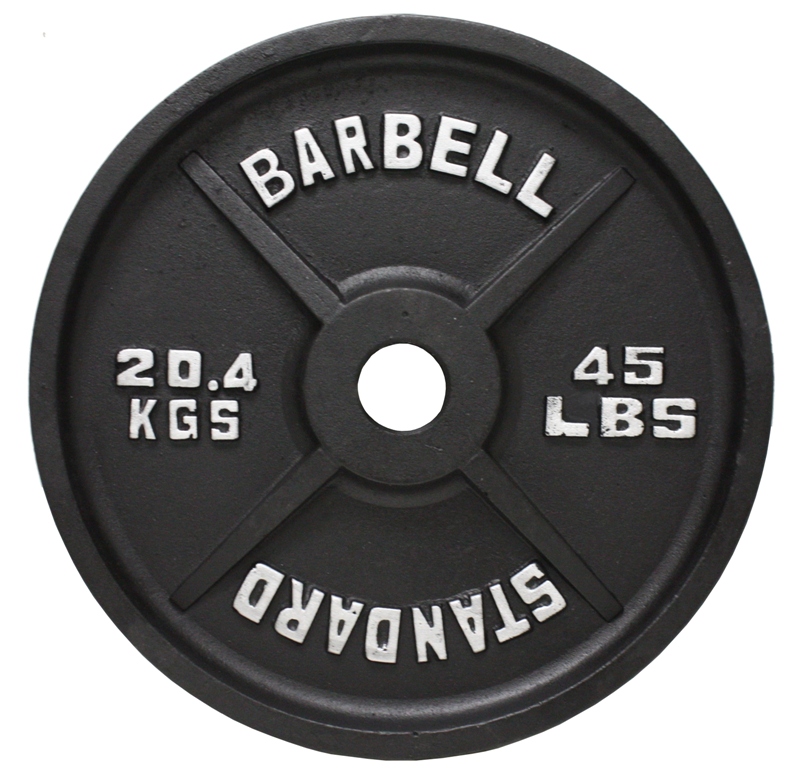
I have a set of 45lb. York milled plates that are 17″ in diameter. In your experience, is this unusual? I wanted to find another inexpensive (Don’t laugh. I got the current set for a good price!) set that matched this, and I am finding that other York milled plates are 17.5″.
Thanks,
Bill
17.5″ is the designed diameter for the Yorks from the info I have. 17″ sounds way off. Do they look just like the 17.5″ ones?
Hi,
I have seen a few of them in person in the last 50 years since college, but not many. From that experience and the many pictures, I’ve seen they look the same. Maybe I was taken?
Thanks,
Bill
Maybe it was some production run in the past where the measurement was off, or could it be some non-milled plate? Just throwing out guesses. I haven’t heard of any counterfeits with this kind of thing.
Hi again,
Just so you can add it to your data bank – these plates are definitely milled. They are by no means in pristine condition, but still have 60% to 70% of what seems to be the original black paint on them and the “45” is in silver. Maybe they are like a rare double strike coin, and one day I’ll be rich! I won’t hold my breath though. I’m too old for much anaerobic work!
Thanks for all the good articles you post!
Bill
Where did the size 450mm come from in the first place? like why is it that size and not lets say smaller or bigger?
I imagine it was a thing that the pioneers felt out based on what bar height off the floor made it easiest for the average man to generate power from a fully spring loaded starting position and lift the most weight with good form, and rounding off the needed plate size for that to a somewhat round number.
I have been searching and really didn’t find anything. Was seeing if someone else knew the answer to it! Curious of the scientific reasoning behind it. Thank you for your information!
It is so that the bar will have a specific ground clearance to avoid crushing your skull during a failed lift. Engineers we’re looking out for us.
Good point! I’ve seen videos of people escaping serious injury because the plates were big enough. I should add a blurb about that.
Hey David, I read these remarks of your a long time ago and since then I have taken for granted that if the 50mm-diameter sleeve of a good-quality barbell can fit into the 50mm-diameter hole of a good-quality plate it is because the latter is actually slightly larger than 50 mm, while it’s only the former to really be 50mm in diameter.
Do you still stand by such explanation?
If you can take the time to watch the following video, none other than the CEO of Fringe Sport says exactly the opposite:
https://www.youtube.com/watch?v=_PeTFJrJNHs&t=328s
The plate hole is exactly 50 mm in diameter, he says, while the diameter of the sleeve is actually slightly less.
I don’t know what to think anymore.
Well let’s do some digging. I have two bars on hand and a bunch of different plates. Measuring with digital calipers, the thicker sleeves of one bar are 49.9mm. The machined iron plates with the smallest holes are 50.6mm.
I have another bar with sleeves 49.5mm, which is definitely off spec.
IPF rules:
“Diameter of the sleeve not to exceed 52 mm or be less than 50”
“The hole size in the middle of the disc must not exceed 53 mm or be less than 52mm”
https://www.powerlifting.sport/fileadmin/ipf/data/rules/technical-rules/english/IPF_Technical_Rules_Book_2021.pdf
IWF rules:
bar: “outer ends (sleeves) = 5 cm diameter / 41.5 cm long”
https://iwf.sport/wp-content/uploads/downloads/2020/01/IWF_TCRR_2020.pdf
From the video it appears Peter is saying a bar should be 49.9mm and a plate 50.5mm. Some brands of plates are smaller than that though.
Some plates are advertised as 50.4mm, 50.3mm, etc, but I’ve never seen a bar sleeve size advertised with a decimal point, just simply 50mm.
I’d be curious if anyone has caliper measurements of other brands of bar sleeves or plates. The plate hole is a little tricky to measure because you have to move the calipers around to make sure you’re getting the exact center diameter.
Just a tip, if you want to measure the bore of a hole, use a bore gauge. You can get cheap versions on amazon that will give you fine accuracy for this purpose.
Great article by the way.
Thanks, I’ll look into bore gauges!
Thank you for this article! It was very informative and helpful